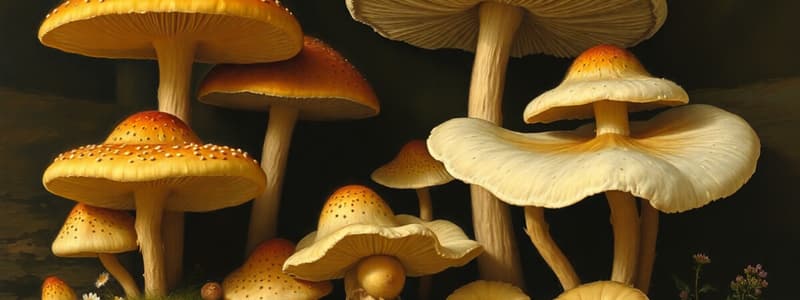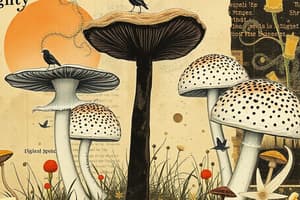Podcast
Questions and Answers
Which structure in Ascomycota is responsible for producing Ascospores?
Which structure in Ascomycota is responsible for producing Ascospores?
- Ascus (correct)
- Mycelium
- Basidium
- Hypha
All fungi in the Basidiomycota division produce antibiotics.
All fungi in the Basidiomycota division produce antibiotics.
False (B)
What is the asexual reproduction process used by yeast?
What is the asexual reproduction process used by yeast?
budding
The harmful effects of fungi include food spoilage and diseases in ______ and animals.
The harmful effects of fungi include food spoilage and diseases in ______ and animals.
Match the following examples of fungi with their correct classification:
Match the following examples of fungi with their correct classification:
What is one of the significant roles of fungi in ecosystems?
What is one of the significant roles of fungi in ecosystems?
Penicillium is a type of fungi that can be harmful to humans.
Penicillium is a type of fungi that can be harmful to humans.
Name one example of edible fungi.
Name one example of edible fungi.
Which of the following best describes mycology?
Which of the following best describes mycology?
All fungi are pathogenic and cause diseases in living organisms.
All fungi are pathogenic and cause diseases in living organisms.
What type of fungi absorb nutrients from dead organic matter?
What type of fungi absorb nutrients from dead organic matter?
Fungi are classified as __________ based on their mode of nutrition.
Fungi are classified as __________ based on their mode of nutrition.
Match the types of fungi with their definitions:
Match the types of fungi with their definitions:
Which type of fungi grow only on dead organic material?
Which type of fungi grow only on dead organic material?
All fungi are unicellular.
All fungi are unicellular.
Name one example of a symbiotic relationship involving fungi.
Name one example of a symbiotic relationship involving fungi.
Which of the following statements accurately describes multicellular fungi?
Which of the following statements accurately describes multicellular fungi?
Asexual reproduction in fungi involves the union of nuclei.
Asexual reproduction in fungi involves the union of nuclei.
Name one method of asexual reproduction in fungi.
Name one method of asexual reproduction in fungi.
The diploid nucleus undergoes ______ during sexual reproduction to reduce the number of chromosomes.
The diploid nucleus undergoes ______ during sexual reproduction to reduce the number of chromosomes.
Match the following divisions of fungi with their corresponding type of spores:
Match the following divisions of fungi with their corresponding type of spores:
What is the primary reproductive structure used by Zygomycota?
What is the primary reproductive structure used by Zygomycota?
Fungi reproduce sexually only through spore formation.
Fungi reproduce sexually only through spore formation.
What is the name of the grayish fuzz commonly seen on bread?
What is the name of the grayish fuzz commonly seen on bread?
Flashcards
Fungi definition
Fungi definition
A kingdom of eukaryotic organisms, including mushrooms, molds, and yeasts. They obtain nutrients by absorbing organic matter.
Mycology
Mycology
The study of fungi, including their structure, reproduction, physiology, and taxonomy.
Fungi Habitat
Fungi Habitat
Fungi thrive in environments with organic matter, including soil, water, and living organisms.
Saprophytic Fungi
Saprophytic Fungi
Signup and view all the flashcards
Parasitic Fungi
Parasitic Fungi
Signup and view all the flashcards
Symbiotic Fungi
Symbiotic Fungi
Signup and view all the flashcards
Mycorrhizae
Mycorrhizae
Signup and view all the flashcards
Fungi Structure
Fungi Structure
Signup and view all the flashcards
Ascomycota
Ascomycota
Signup and view all the flashcards
Ascospores
Ascospores
Signup and view all the flashcards
Yeast
Yeast
Signup and view all the flashcards
Basidiomycota
Basidiomycota
Signup and view all the flashcards
Basidiospores
Basidiospores
Signup and view all the flashcards
Mushroom
Mushroom
Signup and view all the flashcards
Fungi role in recycling
Fungi role in recycling
Signup and view all the flashcards
Edible fungi
Edible fungi
Signup and view all the flashcards
Antibiotics from fungi
Antibiotics from fungi
Signup and view all the flashcards
Fungi as biocontrol agents
Fungi as biocontrol agents
Signup and view all the flashcards
Fungal food spoilage
Fungal food spoilage
Signup and view all the flashcards
Aflatoxins
Aflatoxins
Signup and view all the flashcards
Fungal plant diseases
Fungal plant diseases
Signup and view all the flashcards
Fungi animal diseases
Fungi animal diseases
Signup and view all the flashcards
Multicellular Fungi
Multicellular Fungi
Signup and view all the flashcards
Septated Mycelium
Septated Mycelium
Signup and view all the flashcards
Aseptated Mycelium
Aseptated Mycelium
Signup and view all the flashcards
Asexual Reproduction (Fungi)
Asexual Reproduction (Fungi)
Signup and view all the flashcards
Fragmentation (Fungi)
Fragmentation (Fungi)
Signup and view all the flashcards
Fission (Fungi)
Fission (Fungi)
Signup and view all the flashcards
Budding (Fungi)
Budding (Fungi)
Signup and view all the flashcards
Spore Formation (Fungi)
Spore Formation (Fungi)
Signup and view all the flashcards
Sexual Reproduction (Fungi)
Sexual Reproduction (Fungi)
Signup and view all the flashcards
Plasmogamy (Fungi)
Plasmogamy (Fungi)
Signup and view all the flashcards
Karyogamy (Fungi)
Karyogamy (Fungi)
Signup and view all the flashcards
Meiosis (Fungi)
Meiosis (Fungi)
Signup and view all the flashcards
Zygomycota
Zygomycota
Signup and view all the flashcards
Ascomycota
Ascomycota
Signup and view all the flashcards
Basidiomycota
Basidiomycota
Signup and view all the flashcards
Study Notes
Fungi Overview
- Fungus is a Latin word meaning mushroom
- Mycology is the study of fungi, including their structure, reproduction, physiology, and taxonomy.
General Characteristics of Fungi
- Habitat: Fungi are found in many habitats with organic matter, including terrestrial, aquatic, pathogenic, and as contaminants.
- Mode of Life/Nutrition: Fungi are heterotrophic, meaning they lack chlorophyll and absorb ready-made nutrients from external sources. This can be saprophytic (on dead organic matter), parasitic (on living organisms), or symbiotic (in association with other organisms).
- Structure: Fungi can be unicellular (e.g., yeast) or multicellular (e.g., molds). Multicellular fungi have hyphae, which may be septate (with cross walls) or aseptate.
- Reproduction: Fungi reproduce both asexually (fragmentation, fission, budding, spore formation) and sexually (plasmogamy, karyogamy, meiosis).
- Classification: Fungi are classified based on their spores. Major divisions include Zygomycota, Ascomycota, and Basidiomycota.
Division Zygomycota
- Zygomycota are zygote-forming fungi.
- Zygospores are formed in a round case called sporangium.
- Examples include Mucor, Rhizopus (bread mold), and Albugo.
Division Ascomycota
- Sac fungi produce ascospores in cup-shaped sacs called asci.
- Ascospores are released when the ascus breaks open.
- Yeast is a common one-celled fungus that reproduces by budding.
- Examples include Aspergillus, Penicillium, morels, truffles, cup fungi, and powdery mildews.
Division Basidiomycota
- Basidiospores are borne on a club-shaped spore case called a basidium.
- Basidiomycota includes mushrooms, puffballs, and toadstools.
- In mushrooms, basidia are often located on gills under the cap.
- An average-sized mushroom produces billions of spores.
- Examples include Agaricus (mushroom), Ustilago (smut), and Puccinia (rust fungus).
Importance of Fungi
- Recycling: Fungi, along with bacteria, recycle dead organic matter.
- Edible Fungi: Many mushrooms are edible and cultivated for food.
- Medicines: Some fungi produce antibiotics like penicillin.
- Bio-control Agents: Fungi can be used to control pests and insects.
- Harmful Fungi: Some fungi cause food spoilage (e.g., aflatoxins) and plant/animal diseases (e.g., powdery mildew, rusts). Fungi also cause superficial infections like ringworm and tinea versicolor.
Studying That Suits You
Use AI to generate personalized quizzes and flashcards to suit your learning preferences.



